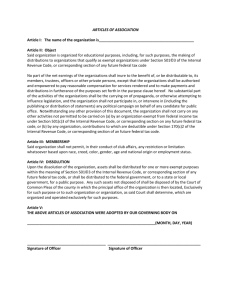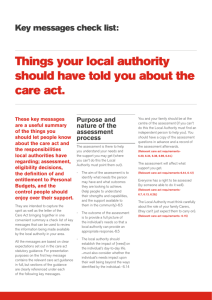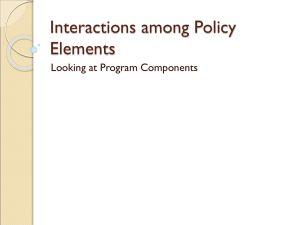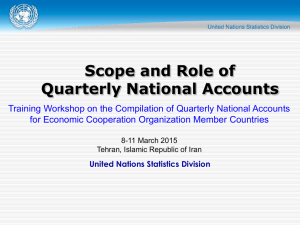View Full Details - Children Services Division
advertisement
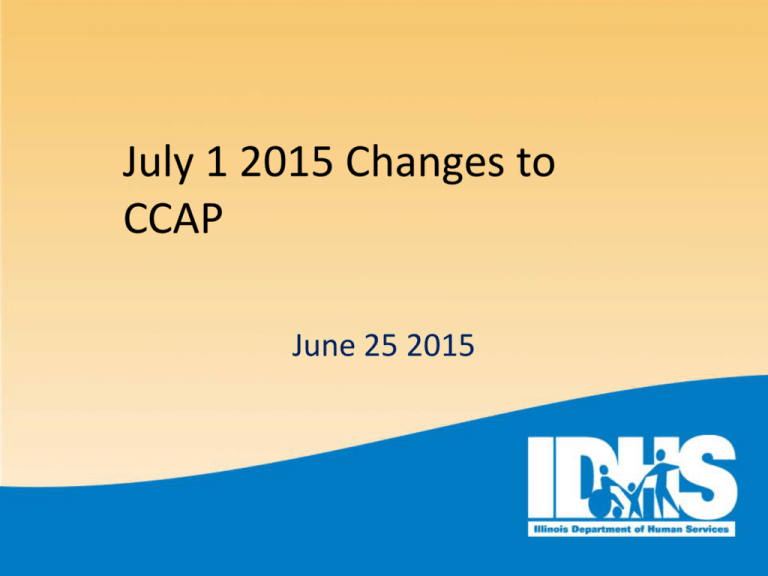
July 1 2015 Changes to CCAP June 25 2015 Purpose of Call • The purpose of this call is to review the policy and procedure changes to the Child Care Assistance Program (CCAP). • The changes are being implemented to reduce CCAP expenditures due to significant projected FY16 funding shortfalls. Despite what is being said… • CCAP is NOT stopping new applications from being accepted and evaluated. • CCAP is NOT ending payments or services to license-exempt providers. • CCAP WILL operate under restrictive polices until sufficient resources are available to serve all eligible applicants. FY ‘16 Funding • We have been instructed to proceed with these changes through Emergency Rule by the Governor's Office. • If additional funding is approved for CCAP, some of these changes may be repealed. – We will keep you updated as we are informed. CCDBG Changes • The CCAP Program Manual will be updated to reflect these changes for an effective date of July 1. – Email notices will be sent once updates are complete. • There will be additional changes in CCAP based on the Child Care Development Block Grant Reauthorization. – These changes will be discussed closer to implementation. Co-Payment Increases • Parent Co-payments are being increased effective to all cases processed on July 1, 2015 or after with a start date of 7/1/15 and after. • Co-payment levels are being restored to levels prior to implementing an 18-month strategy to reduce copayments. • Co-payment adjustments for existing cases will occur at the next redetermination. Co-Payment Increases • The new income and co-payment levels will be effective for cases based on the process date and eligibility start date. • Income levels have been re-indexed to 2015 FPL. • New charts and calculators will be sent soon. • Chart B for families with all school aged children will remain in place with no changes to current policy. Prioritizing Service Groups To the extent resources permit, it is the intent of the Department to provide child care services to all applicants that meet the eligibility requirements set forth in this Section. The Department may, pursuant to subsection(c)(6), alter and prioritize the service groups depending on available resources. Prioritizing Service Groups In the event the Department must limit participation due to insufficient appropriations, applicants will be prioritized as follows: A) Recipients of Temporary Assistance for Needy Families as described in subsection (c)(1); B) Teen parents enrolled full-time in elementary, high school or GED classes to obtain a high school degree or its equivalent; C) Families with Special Needs children; D) Working families whose monthly incomes do not exceed 50% of the most current Federal Poverty Level for their family size. Prioritizing Service Groups • Effective for new applications received on or after July 1, 2015, the Department is imposing prioritized eligibility guidelines to all new Applications. – A new Application is defined as not have eligibility within the last 30 days. • A number of other changes are being implemented to ensure the continued sustainability of CCAP within the Governor's proposed budget. • Cases being redetermined will continue to be eligible as long as they are within the income levels set for redeterminations and all other eligibity factors are met. – If inactive for 30 days or more, the new guidelines apply Procedure • Effective July 1, 2015, documentation and, where possible, electronic verification using State databases must be obtained for the priority area claimed by the client to establish eligibility. • If electronic verification is not possible, request supporting documentation from the applicant. • Verification must be maintained in the family eligibility records and case noted prior to approval for child care payments. TANF • TANF Recipient: – Confirm if the family is receiving a TANF cash grant by referring to ACID Screen 1 Grant History. – If there is a “Y” in the month you are determining eligibility, the case is considered TANF Teen Parents • Teen Parent – This is the same definition as has always been in Section 01.03.05 • Under 20 • Attending full time High School or GED • Required Documentation – High school schedule and/or verification of enrollment in GED program, – Two most recent and consecutive pay stubs, if employed. Please refer to 01.03.02 for those applicants who have not been employed long enough to have received two pay stubs. Teen Parents • If eligible, approve care for the length of the program or grading period. • Reasonable study and travel time, if requested by the parent, will be considered when determining the child care schedule. Do not approve care if the parent is studying at home. • If the teen parent is temporarily suspended from school for 30 days or less, child care services received by the family may continue. • If the teen parent is expelled from school, child care services received by the family may continue for a period not to exceed 30 days to enable the teen to enroll in another approved program. Special Needs “ A Special Needs Child”: (A) a child with a disability, as defined in section 602 of the Individuals with Disabilities Education Act (20 U.S.C. 1401); (B) a child who is eligible for early intervention services under part C of the Individuals with Disabilities Education Act (20 U.S.C. 1431 et seq.); (C) a child who is less than 13 years of age and who is eligible for services under section 504 of the Rehabilitation Act of 1973 (29 U.S.C. 794 New Income Levels Family Size 2 3 4 5 6 7 8 9 10 Intake GMBI $664 $838 $1,011 $1,184 $1,358 $1,531 $1,704 $1,878 $2,051 Rede GMBI $2,456 $3,098 $3,739 $4,380 $5,022 $5,663 $6,304 $6,946 $7,587 Base Wages and Salary • "Base Wages and Salary" − is the amount of gross earned income calculated by multiplying the number of hours worked by the hourly wage plus tips, before any deductions, such as taxes, pension payments, union dues, insurance, etc., are made. • Base wages and salary do not include nonrecurrent or inconsistent pay for overtime, incentives, bonuses, sick, vacation, travel reimbursements or other types of non-recurrent or inconsistent income. Waiting List • IDHS is programing a new denial reason into CCMS for cases that do not fall into a prioritized group. • IDHS will run a report of these cases, listed by effective dates and SDA/Site. • Once the CCAP caseload has reached the level that can be supported by the budget, notices will be sent to those denied informing them to reapply. Exempt Centers A child care center not licensed by the State of Illinois has the burden of demonstrating that it meets the criteria for the exemption it claims (89 Ill. Adm. Code 377), and must certify its facility or program is exempt from licensure including submission of a completed License Exempt Day Care Center Self-Certification form. Exempt Centers • If a parent submits an Application or Redetermination that indicates their child attends a license exempt day care center, verify the provider’s exemption status has been verified with supporting documentation* for the exemption claimed. • If the parent is using a new provider or the existing provider has not completed a License Exempt Child Care Center Self-Certification form (IL444-3461) take the following steps: Exempt Centers • For a new provider or an existing provider that has not been verified with supporting documentation, – Send a Request for Additional Information (RAI) and Form IL444-3461. • Form 3461 must be returned within 10 business days. – Send a copy of the RAI to the parent. Exempt Centers • Do not approve the provider until the center's exemption has been verified. • If the provider does not respond to the first RAI, follow CCMS instructions for generating a second RAI and Form 3461. • If the provider does not submit Form 3461 after the second request, – issue a denial to the parent and provider using reason code #11, and send the parent a Change of Provider Form. Exempt Centers Upon receipt of a completed Form 3461 and supporting documentation, update the CCMS Provider Notes to include Approval of the exemption that corresponds to the exemption box marked. Please note that at the discretion of the Department of Human Services, the center may be asked to furnish a letter from the Department of Children and Family Services (DCFS) that verifies the center's exempt status. *Please refer to the License-Exempt Center Standard Minimum Documentation Matrix License Exempt Child Care Center Self-Certification Minimum Documentation Requirements License Exempt Child Care Center Self-Certification Minimum Documentation Requirements (cont..) Exempt Centers • Exemptions for part day, transient children cared for temporarily, or special activity programs (Exemptions 6, 8 and 9) do not support a child’s development or a parents need to work and will no longer receive funding through the Child Care Assistance Program. Definition of “Provider” • "Child Care Provider" or "Child Care Facility" – any individual, other than a parent, or legal guardian, group of persons, agency, association, or organization that provides programs or services for compensation, exclusively directed towards persons under the age of 18. Definition of Member of the Household Member of the Household: – a person who lives at the same address of the parent, legal guardian, or child as evidenced by factors, including, but not limited to, maintaining clothing and personal effects at the household address, receiving mail at the household address, or using identification with the household address. Client Cooperation with Child Support • Within six months of initial child care assistance eligibility, an eligible family with an absent parent must open an active collection case with the Division of Child Support Services at the Department of Healthcare and Family Services. • A case must be opened against the absent parent of every child within the family’s household. Client Cooperation with Child Support Staff must verify that each child for which child care assistance is requested, and any children required to be included in the family size that client has submitted written verification of working in cooperation with the Division of Child Support Services for each child’s non-custodial parent to: o establish paternity; or o enforce and/or modify existing child support obligations Client Cooperation with Child Support From either: o the Department of Human Services FCRC Form (t/b/d) for clients receiving TANF, SNAP or Medical, or o the Department of HFS Child Support Services (Form t/b/d) Where possible Staff may obtain electronic verification from existing State Databases (IES, KIDS, ACID Screen 2) Background Checks • As a condition of eligibility to receive a State subsidy for providing child care services to eligible families, all license exempt child care providers, except a provider who is related to the child, shall complete and sign authorizations for a State and Federal Bureau of Investigation (FBI) fingerprint-based criminal history record check and submit to fingerprinting, if required, to determine if the child care provider has prior criminal convictions or pending criminal charges. • Providers types subject to a fingerprint-based criminal history record check include: Background Checks • Provider types subject to a fingerprint-based criminal history record check include: – 761 Child care centers exempt from licensing – 764 Child care homes exempt from licensing; and – 765 Relative who provides care in the home of the relative; and – 766 Non-relatives who provide care in the child's home. – 767 Relative who provides care in the home of the child Background Checks • Other persons subject to a background check include: – All persons age 17 18 and over who reside in a child care home exempt from licensing even if those household members are not usually present in the home during the hours the children are present. – This shall also apply to a person age 13 and over who has been tried as an adult and convicted of any crime identified in 89 Ill. Adm. Code, Chapter III, Part 385. Background Checks • Upon receipt of an application, redetermination, or request for provider change, staff shall verify the provider status in the CCMS. • Always perform a provider search before adding a new provider record to CCMS. More To Come The following are being modified/developed and will be sent to all CCR&Rs and Sites once final approval is obtained: – – – – – – – – – Revised application Revised rede Revised copayment charts Revised income/copayment calculation worksheet Notice to Clients and Provider CCAP Talking Points Revised Exempt Center Certification Form Revised Authorization for Background Check form and letter Revised Program Manual sections Revised income/copayment calculation worksheet QnA Q. Would it be possible for you to get the new Co Payment guidelines under the new 50% of the Federal Poverty Guidelines as soon as possible. A. We are finalizing the guidelines and will distribute and post as soon as they are completed QnA Q. If no budget by August, will there still be the federal draw in the middle of the month or is that based on having a State budget? A. The federal draw will continue but the State would still need to have an approved spending plan as part of the budget approved for us to access it. QnA Q. Since our site is not on CCMS, we currently email the Application or the REDE and only the co-payment worksheet. Starting July 1st will we need to also include the supporting documentation, i.e., employer's verification forms, paystubs, school verification, etc. that were not required during the Temporary Shortcuts? A. All documentation should be submitted as a single document. This will keep the dashboard easier to work. QnA Q. What about our current clients (aged 5) that we have approved currently on our site contract. They age out of our program and leave in August if they are eligible to start Kindergarten in September. Currently I close their cases and tell them to re-apply through their local R&R. Can I now transfer their cases to the R&R caseload instead so that they don’t fall off the program (since most are not in the target population) A. If the case was approved beyond the date they aged out, it should be transferred with the remainder of the current eligibility period. If the end date was the date they aged out, and is now more than 30 days ago, the client will need to reapply. If that occurs after July 1 they will have to meet the new restricted guideline. QnA Q. I was wanting to know if you will be creating a document that we can send out to our clients letting them know of the changes or should we create a document and inform our clients? A. We are working on a notice to clients and providers. We will supply these notices to all CCAP contractors once completed and approved. QnA Q. When an ineligible family is placed on the waiting list, will it be a general waiting list for our county? And when the CCAP unit staff see a slot open to serve another family will they contact the center that submitted the application to see if they can serve the family; or will the family be contacted and told they can contact any child care center (accepting CCAP) for enrollment? A. Details on the waiting list are still being developed. The current plan is to maintain a statewide list based on CCMS denial reason and date. BCCD would notify clients when they should re-apply based on availability of resources. QnA Q. Are the effective changes going to take place on July 1 or on mail received July 1 and after? If the changes are effective on July 1, then how will we handle the cases in pending? A. The new income and co-payment guidelines apply to all cases processed on July 1, 2015 or after with a start date of 7/1/15 and after. QnA Q. With teen parents being a priority service group (age 19 and under), if they are working does that mean they automatically get approved as long as they meet the normal income guidelines of below 185% of the poverty level? A. Teens will be defined as in current policy 01.03.05 " Teen parents are eligible to receive child care services while they attend school to obtain a high school degree or its equivalent. Teen parent means parents through 19 years of age." An employed teen, not in HS or equivalent, would be eligible it they fall within the new intake income limits. QnA Q. When does the 12-month eligibility begin? A. We are still discussing a 12-month eligibility policy. This will be announced with advance notice. All States must enact 12 month eligibility by September 2016. QnA Q. Are the State's new income guidelines really going to be 50% of the Federal Poverty guidelines? That would mean that a family of 2 could not earn more than $7965 a year or $663.75 a month. OR did the Governor want to reduce our current guidelines of 185% of Federal Poverty amount by 50 points which would mean that the new income threshold would be 135% of the Federal Poverty guidelines? A. At this time very low income is defined at 50% of the Federal Poverty level. QnA Q. Please give us some clarification because at the 50% rate that would mean that families would be better off not working and going shopping for a Head Start program who is using the 100% of the Federal Poverty guidelines. There would be no need for the Child Care Assistance Program. A. At this time very low income is defined at 50% of the Federal Poverty level. QnA Q. Since the eligibility has been so restricted will we still be under the rule that we cannot charge any less for our private pay parents? We can see that many of the parents in our area will not meet the 50% FPL requirement and are worried that we will not be able to provide services for them. A. We have not been given instruction to change any policies other than what has been announced so far. The policy (06.05.01) that states providers cannot charge the state a higher rate than private pay families remains in effect. QnA Q. What is the status on eligible for families where there is no social security number? I don't want to call attention to those families since they represent some of our most vulnerable. A. At this time the population without SSN has had no changes proposed, nor those children that do not meet the guidelines for citizenship. QnA Q. when you set up the denial code it might be helpful to have two: one where the family is between 50-185% of FPL and another for families over the current income, to help sort families if we do get to pull from the wait list. A. We should be able to use the existing cancellation code for over income (at 185%) at rede. Denial for reason that client does not meet criteria for the priority service group should be considered. QnA Q. I was thinking about the phone meeting after it ended and wanted to make sure I had heard correctly. The maximum income beginning July 1 for new CCAP families will be below 50% of poverty level. Not 150%. Fifty percent? A. That is correct. This equals about 13% of State Median Income or SMI. QnA Q. Will RPY’S remain eligible after the new guidelines are in place? A. We have not been given instructions to change RPY policy at this time. QnA Q. We have several clients who are teachers (school bus drivers, paras, cafeteria staff etc). They typically do not have an active case in the summer and then re-apply when school begins. For these cases would we be able to do a job search? We had one that just came up yesterday and she called and is on unemployment for the summer but will return in the fall to work at a school. A. Job Search policy has not changed. The client must state they are looking for a job during the summer months to continue care. If the case is inactive for more than 30 days, they will need to re-apply and meet the new guidelines. QnA Q. Will there be a letter or “talking points” sent out to CCR&R’s? Will there be a letter to use or print out and give to parents that request something in writing about the changes? If not something to print out for parents will there be “talking points” on what the CCR&R’s say to clients/providers? In the past when we had information change and we had guidance it made it a lot better because we were all saying the same thing. It seemed we were all on the same page throughout the state on what was being said. A. Notices and talking points are being developed. QnA Q. Will the new changes begin for paperwork that is date stamped for 7/1/15 or do we have to use the new changes on paperwork that was received prior to 7/1 but has not been processed yet? A. The new income and co-payment guidelines apply to all cases processed on July 1, 2015 or after with a start date of 7/1/15 and after. B. The restrictive intake policies apply to all applications received July 1 and after. QnA Q. I understand the state is keeping track and may have a report for cases on the waiting list. Is this something we can do internally as well so we know how many cases and who we have waiting? A. Agencies may keep their own internal waiting list for your information but notices will be sent using the IDHS waiting list report. QnA Q. Will the application be updated to reflect the changes? Example: can the optional for social security numbers for family members in the provider’s home be removed? Also, the DOB in the system for the provider is mandatory and on the application it is not. Can this be updated as well? A. Minor changes were made to the application. A larger rework of the application will be part of the CCDBG reauthorization process. Q. We have wondered about families with current elig with us, who will want to switch to a new provider. Primarily we are thinking of kids who will receive care elsewhere in the fall as they go to kindergarten. It would be good to have a way to transfer their elig so it's continuous and they don't lose elig. A. If the case has an active elig period, it can be transferred to the new agency. B. Remember the definition of a new application is if there has been not approve for more than 30 days. QnA Q. These changes will reduce providers to provide child care services to so few that many centers will close. Sad day for parents. I'm close to retirement age so these may be my last days as well. But it will sure save the state millions of dollars. However parents will not be able to pay private pay rates so they will be forced to go on state aid which may reduce those millions saved. I know you are only following orders. I guess since the dept is moving forward you believe there is no chance that the legislators will reverse these drastic changes. 😢 A. Hope Springs Eternal This Just In… Q. Will providers be paid for services provided after 7/1 and before a budget is passed once a budget passes? Or provide services at our own risk? A. We have not gotten a clear direction other than statements made by the Comptroller. This Just In… Q. For family with child with special need, need IEP or IFSP? A. Yes. Accepted documents for age groups will be included in procedures. This Just In… Q. For Special Needs, what income level for family? A. As long as the child meets documentation requirements and falls within the Redetarmination income guidelines, they are eligible. This Just In… Q. For Special Needs, does the parent still need an approved activity? A. Yes. Q. For Special Needs, will eligibility be for just the child with the special need or for the entire family. A. The entire family. Q. For Base Wage what do we do about OT? A. Rule states only to count consistent income. We are in discussions over how we will define consistent overtime income and will let you know ASAP. • New definition of whose included in family size? In household member slide. Q. Child support: what if reason can't? Like domestic violence? A. Yes, Domestic Viloence is a reason for noncompliance with Child Support. This should be documented by HFS or on the KIDS system. Q. How document cooperation? Need for each child in household? A. Yes, for each child Q. Does this definition of Special Needs apply only to new Apps to identify if the client falls in one of the priority categories, or will the new definition also apply to Rede/COI's? Meaning, will continuous clients still be permitted to only submit documentation from a Doctor for their 13+ year olds? A. Documentation needs for children over 13 have not changed at this time. • So as of 7/1 we only approve new apps based on priority status of teen pt, homeless, tanf cash, family with child with so needs or at 50% FPL or below. Do I have that right? No other approvals for new apps? • does this definition of Special Needs apply only to new Apps to identify if the client falls in one of the priority categories, or will the new definition also apply to Rede/COI's? Meaning, will continuous clients still be permitted to only submit documentation from a Doctor for their 13+ year olds? Thanks for Attending . . . and for all that YOU do for the children and families of Illinois!! July 1 2015 Changes to CCAP June 25 2015



